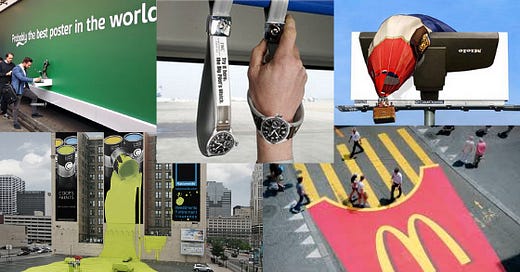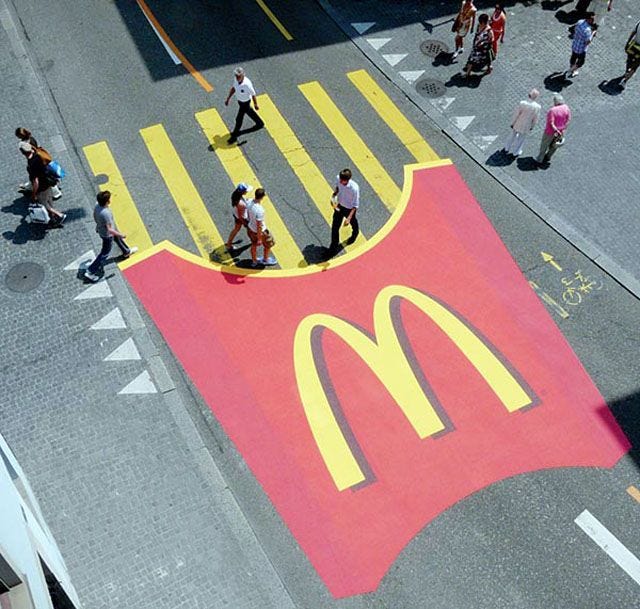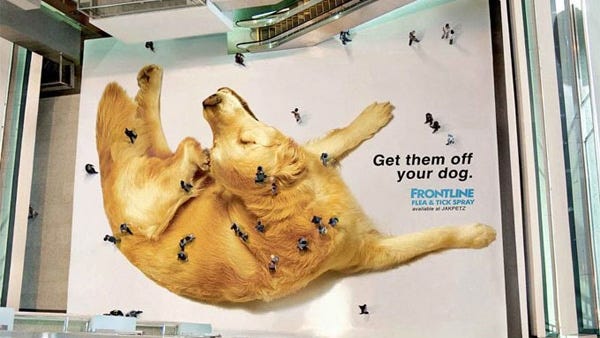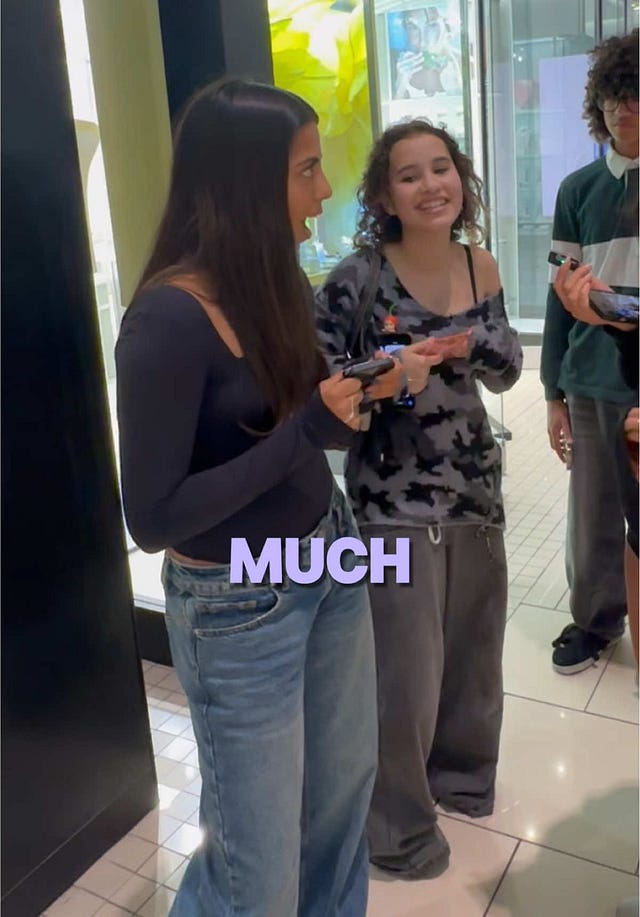ANOTHER DAY—ANOTHER STARTUP INSIGHT
We’re opening up sponsorship opportunities for early-stage founders who want to showcase their startups to a highly engaged and targeted audience. Please check out more details about this sponsorship at the link below:
When you're a startup founder, you're often faced with the same problem:
Big dreams, small wallet.🤷♀️
One of the biggest myths in the startup world?
“Marketing is expensive. We can’t afford it until we raise money.”
It’s a mindset that holds a lot of early founders back—thinking that real marketing requires a massive budget, an agency, or a viral influencer campaign.
But here’s the truth: You don’t need big bucks to make a big impact.
Some of the most iconic startup moments didn’t come from million-dollar ad spends—they came from bold, unexpected, scrappy tactics.
It’s called: Guerrilla marketing.
It’s not about outspending your competitors.
It’s about outsmarting them.
Forget billboards and influencer mega-deals—Guerrilla marketing is all about creativity over cash, using surprise, creativity, and low-cost tactics to make people stop, look, and remember you.
Here’s how you can play smart—even when your budget says you can’t.
What is guerrilla marketing?
Coined by Jay Conrad Levinson in the 1980s, guerrilla marketing is all about using unconventional tactics to promote a product or brand in ways that are surprising, memorable, and cost-effective.
Unlike traditional ads that rely on paid media, guerrilla marketing leans on imagination, timing, and location.
It’s about disrupting the mundane, sparking emotion, and encouraging people to talk—without blowing your budget!
When done right, guerrilla marketing blends so naturally into people’s daily lives that they might not even realize they’re being marketed to. And if it really hits the mark, it can catch fire—spreading your brand far and wide, maybe even globally.
Will you know it when you see it?
That’s the magic of guerrilla marketing—you might not even realize it’s happening until you're smiling, snapping a photo, or telling a friend about the weird-but-awesome thing you just saw.
Unlike traditional ads that scream “BUY NOW,” guerrilla marketing sneaks in through creativity and emotion. It could be a piano mysteriously placed on a busy sidewalk, a sticker on your coffee cup with a clever message, or a pop-up art installation that makes you stop and wonder, “What’s this about?” Then boom—brand message delivered. Subtle, but unforgettable.
If it makes you pause, laugh, share, or think—it’s probably guerrilla.
The role of technology in guerrilla marketing
Guerrilla marketing might start in the real world, but tech is what helps it spread.
QR codes turn physical campaigns into digital funnels.
Social media turns one small street stunt into a global moment.
AR filters, geotags, and live streams make it easier than ever to connect offline moments with online buzz.
Even a low-budget campaign can blow up if you make it easy for people to share.
Think: “Would someone want to post this to their Instagram story?”
If the answer is yes, you’ve just turned one viewer into hundreds—thanks to tech.
LATEST POSTS:
Why guerrilla marketing is a great way to get your message out
For early-stage startups, guerrilla marketing is more than just clever—it’s strategic.
Here’s why it works:
Low cost, high impact: You don’t need a big budget—just a bold idea.
Cuts through the noise: People ignore banner ads, but they don’t ignore a guy in a banana suit handing out free coffee.
Builds brand personality: It shows your company has a pulse. Humor, heart, rebellion—whatever your vibe is, you can show it off.
Encourages word of mouth: People love talking about things that surprise them.
In short, guerrilla marketing levels the playing field. You may not outspend the big guys—but you can outsmart them.
Real-world examples of guerilla marketing campaigns
Guerrilla marketing isn’t just a theory—it’s been used by both scrappy startups and global giants to create buzz, spark conversation, and drive real results.
Below are some clever campaigns that show how thinking outside the box (or budget) can turn heads and win hearts.
1. McDonald's used guerilla marketing tactics to attract customers
McDonald’s turned an ordinary pedestrian crosswalk into a giant pack of fries. The white crosswalk lines became "french fries" with a giant McDonald’s bag at the base.
It blended into the real world but stood out just enough to be Instagram-worthy. Pedestrians walked through the ad, literally interacting with it.
When the kids spot it, they will immediately want to enjoy a happy meal at the next McDonalds!
2. Frontline’s interactive floor ad
In a shopping mall, Frontline (a flea prevention brand for dogs) placed a huge floor sticker showing a scratching dog. From the upper levels of the mall, people walking across the image looked like "fleas" crawling on the dog.
It was funny, clever, and got people involved without even trying.
Observe the environment with different perspectives—sometimes the public becomes part of your campaign without realizing it.
3. Airbnb’s Craigslist hack
In the early days, Airbnb didn’t have a big marketing budget—so they got creative. The team noticed people were using Craigslist to rent out rooms or offer short-term stays. So every time someone posted a listing on Craigslist that matched their audience, the Airbnb team manually emailed them, suggesting they cross-post it on Airbnb’s platform. It was tedious, but it worked. Hosts joined, listings grew, and demand followed. After initial traction, they built a tool that automatically scanned new Craigslist posts and sent outreach messages at scale.
That was how Airbnb tapped into an existing, massive audience without paying for ads.
4. Evry Jewels's mall giveaway + social media marketing
A jewelry startup made TikTok videos where they visited malls, walked up to young women (their ideal customers), and asked fun or thoughtful questions on camera. After the short convo, they’d gift them a piece of jewelry—no strings attached.
The result? Genuine surprise, happy reactions, and viral content that doubled as both brand exposure and market research.
It created emotional, authentic moments that resonated on social media—while putting their product directly into customers’ hands.
 Tiktok failed to load.
Tiktok failed to load.Enable 3rd party cookies or use another browser
5. Antimetal’s pizza outreach
The CEO of Antimetal, a startup helping companies save on AWS cloud bills, made a bold move: he spent his entire marketing budget on pizza.
He ordered pizzas for potential customers, wrapped them in custom Antimetal-branded packaging, and included a handwritten note explaining what the startup does and why it could help.
No paid ads. No cold emails. Just hot pizza and a personal touch.
It broke through the noise, felt personal, and showed serious hustle. Plus, who says no to free pizza?
Read this story here:
Some ways early-stage founders can apply guerrilla marketing
You don’t need a massive budget to make a big impression. With the right mix of creativity, hustle, and boldness, guerrilla marketing can help early-stage founders connect with real users, build hype, and stand out from the crowd.
Here are some simple, scrappy ways to put guerrilla marketing into action:
1. Start where your audience hangs out
Instead of trying to conquer the internet from day one, begin in a place where your target audience already gathers.
Example:
If you’re building a productivity app for students, go old-school: set up a small booth on a university campus and offer free slices of cake to anyone who downloads the app on the spot. Maybe add a sign that says: “Stressed? Have some cake—and an app to help you focus.”
Cheap. Fun. Unexpected.
And you’ll get real users + feedback.
2. Turn everyday objects into marketing
Use physical space in clever ways.
Example:
A laundry delivery startup placed branded clothes hangers on doorknobs in dormitories and apartments. Each hanger said, “Your clothes deserve a better life.”
It cost almost nothing—and got people curious enough to check them out.
3. Create a moment worth sharing
Design experiences that make people stop, laugh, or pull out their phones.
Example:
A mental health app startup chalked motivational messages like “You’re doing better than you think” on sidewalks outside libraries during exam season—with a small QR code to their app underneath.
You will see suddenly students were snapping pics and sharing it on Instagram Stories.
4. Use props and costumes to make a statement
A bit of theater goes a long way when done right.
Example:
A dating app founder wore a giant heart costume and handed out “bad date insurance cards” outside a Valentine’s Day event. The card led to their app with a message: “Ready for a real match?”
Eventually, people laughed, some downloaded the app, and it got shared organically.
5. Hijack existing events (in a friendly way)
You don’t have to host your own big event—just plug into one that already exists.
Example:
A new energy drink brand handed out free cans at 7 a.m. outside a tech hackathon, with signs that read: “Survive the code. Drink this.”
It cost maybe $100 and landed them their first group of loyal fans.
6. Play into humor or local culture
People remember things that feel clever or hyper-relevant.
Example:
A bike repair startup in a college town left “flat tire tickets” on locked bikes that looked like real parking tickets. But instead of a fine, it read: “We fix tires fast. First repair free.”
Bonus: it made riders laugh instead of angry.
7. Give value first, sell later
Guerrilla marketing doesn’t always need to feel like marketing.
Example:
A founder of a budgeting tool for freelancers created a simple “freelancer tax checklist” PDF and posted it on Reddit design and writing threads. The checklist linked back to the product.
No ad spend. Just value—and conversions followed.
The guerrilla mindset
These aren’t just hacks—they’re part of a mindset:
Think outside the box.
Focus on surprise + delight.
Be where your people already are.
Use constraints as creativity fuel.
Don’t ask for attention—earn it.
If you’re bold enough to sell cake to strangers or wear a banana costume to make your point—you’ve got the spirit of guerrilla marketing.
Final thoughts
Guerrilla marketing isn’t just a fun tactic—it’s a mindset.
For early-stage founders, it’s about punching above your weight, staying bold, and turning constraints into creative gold.
The best campaigns feel organic, authentic, and unforgettable.
So go ahead—get weird, get noticed, and get people talking.
THANKS FOR READING!
- Gracie from What A Startup















This is amazing.